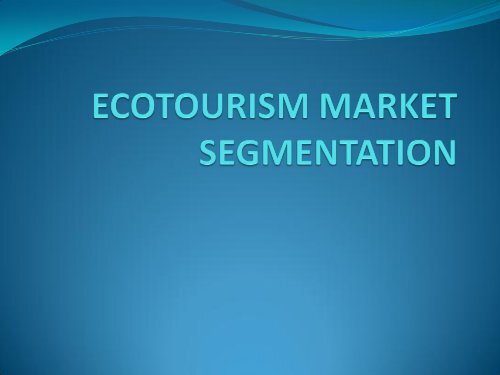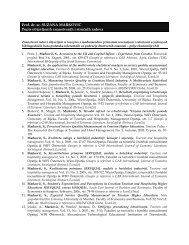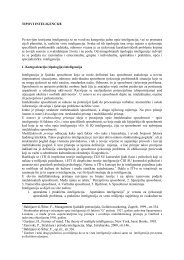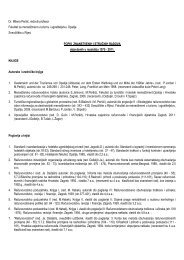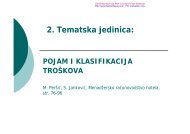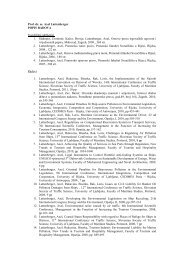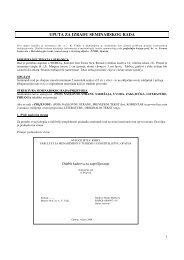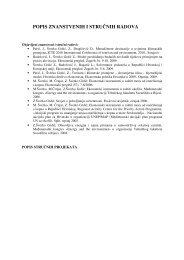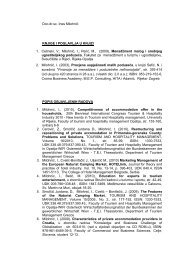ECOTOURISM MARKET SEGMENTATION - LUMENS
ECOTOURISM MARKET SEGMENTATION - LUMENS
ECOTOURISM MARKET SEGMENTATION - LUMENS
You also want an ePaper? Increase the reach of your titles
YUMPU automatically turns print PDFs into web optimized ePapers that Google loves.
<strong>ECOTOURISM</strong><br />
• Increasingly parks, nature reserves and natural<br />
settings are becoming popular tourist destinations.<br />
• The development of environmentally sensitive tourist<br />
resorts responds to the fast growing ecotourism<br />
markets and the general public’s awareness of<br />
environmental preservation and sustainability.<br />
• Ecotourism is one of the fastest growing type of<br />
tourism. Trends indicate that the growth of ecotourism<br />
coupled with the larger market segment of nature<br />
tourism far surpasses that of tourism in general.
• While the lack of clear differentiation between ecotourism and<br />
other forms of nature tourism makes tracking ecotourism<br />
development difficult, it is obvious that travel to natural areas is<br />
increasing at a tremendous rate.<br />
• In order to measure ecotourism growth special set of indicators<br />
could be used, which do provide insight into the current and<br />
future magnitude of the sub-industry: growth in ecotourism<br />
education, international recognition and regional support,<br />
international funding opportunities, growth in tourism ecocertification<br />
and eco-labelling programmes. Each of these<br />
indicators provides a glimpse beyond the traditional statistical<br />
analysis, into the current position of ecotourism and its expected<br />
future growth.
• Many destinations try to include some kind of ecoactivities<br />
in their tourism offer in order to increase the<br />
attractiveness on the market. Demand for destinations that<br />
include natural elements such as national parks and local<br />
parks, forests, waterways and others continues to increase.<br />
• As visitation to natural areas increases, including<br />
ecotourism visitation, so does the demand for travel<br />
professionals to accommodate these tourists.<br />
• There have been an increase in tourism professionals, such<br />
as travel agents, tour operators, tour guides etc., that focus<br />
either on the ecotourism or at least, the nature tourism<br />
market.
ECOTOURISTS<br />
• Ecotourists could be defined as tourists seeking<br />
nature-based learning experiences and behaving<br />
in an environmentally and socio-culturally<br />
sustainable manner.<br />
• Ecotourists are not a homogeneous market, but<br />
display a range of motivations, behavior and<br />
other characteristics.
• Market segmentation is the process whereby a market<br />
such as ecotourists is divided into distinctive subcomponents<br />
or market segments so that appropriate<br />
marketing and management strategies can be<br />
developed for each.<br />
• Two levels of ecotourism market segmentation:<br />
• To determine how ecotourists differ from consumers and<br />
tourists in general<br />
• To identify distinctive ecotourist groups
• Standard criteria that are used in market<br />
segmentation:<br />
• Motivation, attitude and behaviour<br />
• Geographic location<br />
• Demographics
Motivation, attitude and behaviour<br />
The ecotourism spectrum<br />
HARD (active, deep)<br />
• Strong environmental<br />
commitment<br />
• Enhancive sustainability<br />
• Specialized trips<br />
• Long trips<br />
• Small groups<br />
• Physically active<br />
• Physical challenge<br />
• No services expected<br />
• Deep interaction with nature<br />
• Emphasis on personal<br />
experience<br />
• Make own travel<br />
arrangements<br />
SOFT (passive, shallow)<br />
• Moderate or superficial<br />
environmental commitment<br />
• Steady state sustainability<br />
• Multi-purpose trips<br />
• Short trips<br />
• Larger groups<br />
• Physically passive<br />
• Physical comfort<br />
• Services expected<br />
• Shallow interaction with nature<br />
• Emphasis on mediation<br />
• Rely on travel agents and tour<br />
operators
Geographical segmentation<br />
• One of the most widely used criteria for the<br />
segmentation of tourist markets<br />
• Majority of ecotourists reside in the developed regions<br />
and dominant the ecotourism market in most of the<br />
developing world<br />
• The most important ecotourism markets: USA, UK,<br />
Germany, Canada, France, Australia, Netherlands,<br />
Sweden, Austria, New Zealand, Norway, Denmark.
Socio-demograpic criteria - segmentation<br />
• Gender (more females)<br />
• Age (ecotourists older of average)<br />
• Education, income and occupation (well educated,<br />
higher income levels)
Size of the ecotourist market<br />
• UNWTO – estimating that ecotourism accounts for 10-<br />
15% of global tourism<br />
• Greater share of soft ecotourists (less hard ecotourists)
Literature:<br />
• Weaver, D.: Ecotourism, John Wiley & Sons Australia, Milton, 2001.


